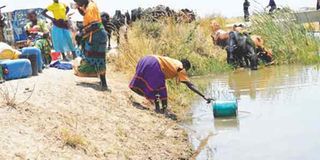Water scarcity threat to Africa’s existence

Water scarcity is fast becoming one of this century’s most complex challenges. PHOTO | FILE
What you need to know:
More than four billion people face severe water scarcity due to withdrawal of more water than is sustainably available.
As global weather patterns continue to shift and human population growth rates rise, water scarcity is fast becoming one of this century’s most complex challenges.
More than four billion people face severe water scarcity due to withdrawal of more water than is sustainably available.
In Africa, the reduced access to clean water sources not only affects human welfare in urban and rural areas but also claims the wildlife species, fragile ecosystems and communities that depend on them.
Water-dependent mammals such as the elephant and rhino — already decimated by poaching — also contend with changes to their habitats. In eastern Africa, rainfall is projected to increase but a significant decrease is expected in the south.
Across the continent’s rapidly industrialising landscapes, the risk of flash floods and harsh droughts is high.
In West Africa, the biodiversity haven of Regional Parc W received only two-thirds of its usual rainfall in 2012.
The transboundary protected area is a Unesco World Heritage Site featuring diverse vegetation from savannah woodlands to riparian forests and flooded plains.
It is also home to the largest concentration of elephants in the region as well as significant numbers of big cats and the rare West African giraffe — threatened species forced to roam outside their usual range in search of water.
Smaller species struggle to adapt to the drastic reduction in rainfall and drying up of water holes. Larger mammals such as elephants are often forced to dig in dry stream beds.
While they may strike low water tables, the hole creates a trap for buffaloes and antelopes, making them easy prey for lions and leopards on the hunt.
For human populations neighbouring national parks and reserves, wildlife moving out of their usual territory threatens their livelihoods at a time when they are unstable due to water shortages and reduced harvests.
To keep wandering wildlife from their homesteads and farmlands, they have adopted wildlife-friendly mitigation techniques but many wild animals still fall victim to retaliatory killings.
Coupled with the ecological disturbances brought about by climate change, contact with other species outside of protected areas is causing a spike in infectious diseases among wildlife and livestock.
Until wildlife management authorities and research institutions conduct extensive animal disease surveillance, events such as the mass death of flamingos in Kenya’s Lake Nakuru National Park are a reality for the remaining species.
A recent study on river quality and human welfare in the Chobe National Park landscape shows that when wildlife has access only to rivers during periods of drought, the health of local communities suffers.
The depletion of other surface water resources during dry seasons pushes animals to forage near rivers, which affects the quality of the river as it travels downstream where human beings use it.
Conservation planning and preventing wildlife habitat loss will also minimise the concentration of animals in riparian corridors and ensure surface water resources are not degraded.
Mitigating the effects of climate change through reforestation projects in the Mau Forest ecosystem in Kenya has helped to secure a vital source of water.
Increasing demographic pressure and unsustainable agricultural practices are also driving the breakdown of landscapes on the continent.
Communities in southern Tanzania monitor river health and engage in conservation-friendly agriculture practices.
Not only are they maintaining critical habitats for the landscape’s wildlife, they are also building their resilience to climate change through strategic conservation.




